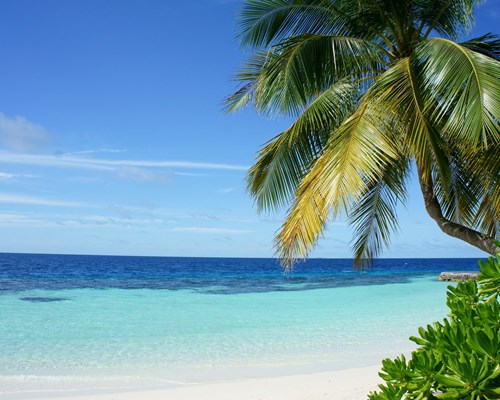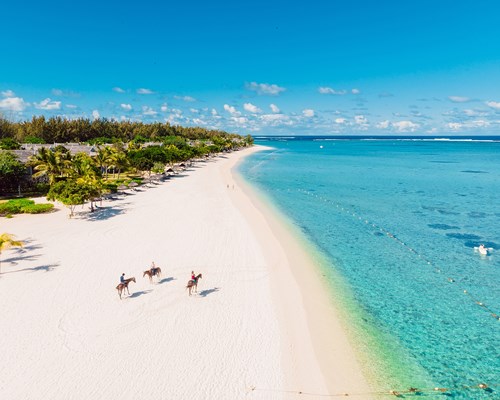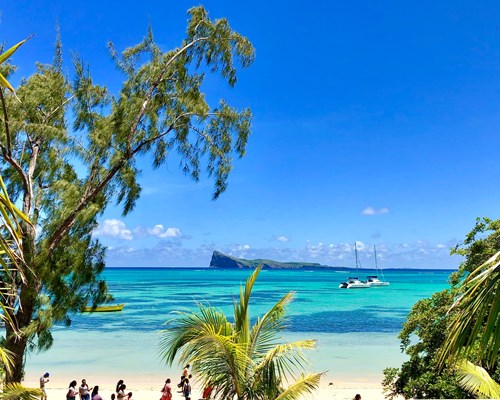Glistening beaches rule the coasts, jungle-clad mountains dominate the landscapes and luminous coral reefs saturate the shimmering bays. Mauritius is enticing more tourists eavery year to make their paradise dreams a reality. From sunset yoga to hiking up cascading waterfalls, there is so much to experience in this heavenly destination.
Beaches in Mauritius
Warm shallow lagoons, bright white sands and only palm trees to share it with, the beaches first drew travellers to Mauritius and, for many, are the be-all and end-all of trips here. Locals pay great respect to the source of their newfound economic wealth so you’re unlikely to find a beach which isn’t clean and well-cared for, many stocked with snack stalls and all-important coconut vendors.
As more and more hear about the beach bliss on Mauritius, a few spots in Port Louis and North Mauritius are now more beach parties than restful retreats, especially when locals roll up at weekends. But let’s just remember, this coastline measures an impressive 330km all told. If alone time is what you’re after, it doesn’t take long to find a secluded cove all of your own.
Popular beaches in Mauritius

La Cuvette Beach, North Mauritius
Ideal for swimming and sporting, the waters here are super calm and don’t have the rocks and reefs of many other beaches. All the waterskiers, sailors and windsurfers that head here at weekends from the Grand Baie certainly agree. Grab lunch from one of the many vendors so you don’t have to waste a second away from the water or, for that matter, give up your coveted spot on the beach... This is one of the few spots in the Grand Baie area where you can hire sun loungers.

Péreybère Beach, North Mauritius
Holidaymakers love Péreybère for its proximity to the Grand Baie’s bars and restaurants, without the Baie’s boisterousness. This little cove between Grand Baie and Cap Malheureux is now better known than it is secluded, but everyone loves it all the same. And we mean everyone: tourists, locals, fish, birds... Little longer than 150m, this teeny cove can get pretty cosy at peak times. Yet somehow it manages not to feel overcrowded. Maybe because everyone seems to have something to do? Clear, protected waters for the swimmers, street food and coconuts for the hungry, magnificent sunsets for the sentimental... A well-stocked supermarket? Check. Souvenir shops? Affirmative. With all the local delicacies and drinks in Péreybère, it's not hard to stay until the sun goes down.

Belle Mare Beach, East Mauritius
This pristine beach is one of the most beautiful beaches in Mauritius. Mauritius’ longest beach - stretching from the village of Belle Mare to Trou-d’Eau Douce - is a beauty and so free of people in the week that it looks exactly like a computer screensaver. The south-east coastal gem remains untouched with stretched, silky-soft sand across casuarina trees.
Dip into the warm, diamond blue ocean or indulge in peacefulness as you take a ride on a horse into the horizon of Mauritius paradise. Sand and seafloor can vary dramatically according to location but as a rule of thumb, the southern parts are less rocky than the north and are where the food vendors like to hang out.

St. Felix Beach, South Mauritius
"A beach made of dreams" as some say. St. Felix Beach dazzles with satin sand and cerulean waters - this beach rules the very South coast of Mauritius!
Stunning yet mysterious, this coast is split into two. The second part closer to Morne is soaked up with intimate settings and emerald-green hues, idyllic for perfecting that sun-kissed glow.
Due to strong currents, swimming is not recommended at this beach, but the picture-perfect seascape lashed into balmy weather makes a perfect spot for tanning and relaxing.

Flic en Flac Beach, West Mauritius
The water is so translucent at Flic en Flac beach that you can probably count individual sand grains on the sea bed! Scuba diving here is an out-of-this-world - a huge reef chocked with marine wildlife shelters this west coast bay from currents and so makes it a popular snorkelling and swimming spot, especially with families.
Peckish for some munch? Grab some spiced street food as you take in the gorgeous views of the exotic mountainous seascape. Ongoing development of the seaside town behind the beach means it’s started going the way of the party crowd - a boon if you like to roll off the beach and onto a barstool.
The wide, sandy shore is another draw, and if you spend the day, you can expect to see spontaneous football and volleyball matches – join in to give yourself something to drink to.

Le Morne Beach, West Mauritius
Being situated on the fringe of Le Morne Brabant mountain, this public beach is known for its spectacular scenery gleaming with authentic Mauritius! With white, coral sands fringed over emerald palms lapping turquoise waters, Le Morne is one of the most photographed Mauritian beaches.
An ideal wind blows almost year-round against southwestern Le Morne, making this possibly the best beach around for windsurfing, kitesurfing and good old-fashioned surfing-surfing beneath the impressive Le Morne Brabant mountain (which has UNESCO World Heritage status). Professional kitesurfers start the annual Kiteival race here in July, when things are busiest, but you’ll find plenty of people catching waves throughout the year. If you’re not yet up to taking on the fearsome One-Eye or joining a trip to the big waves further offshore at Manawa, the likes of the Pryde Club, Ion Club and Le Morne Kite schools will get you there.
Mauritius geography
Mauritius history
Wildlife in Mauritius
Activities in Mauritius
Watersports
Diving in Mauritius
With beautiful conditions year-round, there’s no particular ‘diving season’ in Mauritius. That said, visibility is naturally affected by tides, waves and rain. December to May is considered the peak diving months as more often than not waters are clear, calm and blissfully warm. If you prefer to play it safe, June to August are the months best avoided, as strong winds may make their way through and water visibility is at its lowest.
The range of diving sites here has plenty to keep you busy, with majestic underwater arches, caves and tunnels, never-ending stretches of coral reef and 22 rusted wrecks, all reachable by boat in 10 to 20 minutes. The islanders know they’ve been blessed and there are around fifty dive centres registered with Mauritius Scuba Diving Association, many PADI and CMAS certified. Most are based in hotels and resorts, though can often be used by non-residents.
What we love about the Mauritian dive centres are their dogged efforts to preserve the Indian Ocean’s fragile, underwater topography. You won’t ever find yourself fighting for space at a crowded dive site, nor see boats being anchored. Mooring buoys are used instead, according to Mauritius Scuba Diving Association (MSDA) guidelines, ensuring all the gorgeous coral stays intact for future generations.
For those who prefer to keep their head above water, most of the larger hotels arrange snorkelling trips and rent or provide for free all the equipment you’ll need. If you’re going it alone, the top snorkelling spots line the east coast, with the huge Blue Bay Marine Park in the southeast, plus Trou D’eau Douce and Mahebourg Bay further up, all stuffed with colourful reefs and even more colourful fish. Note, however, that this coast is also the most exposed to wind, and from June to August visibility can be rather hit and miss. On the fish front, the north’s calm lagoons hardly pale in comparison, with family-favourite Trou Aux Biches and Pointe aux Piments, known for sea turtle sightings.
Surfing in Mauritius
Once upon a tide, Tamarin Bay in the West was the Mauritian equivalent of Bondi Beach, made famous for mammoth swells of up to 10ft by the surfing documentary, The Forgotten Island of Santosha in the ’70s. Today, the hype and the waves have died down slightly. Those 10-footers are less consistent than the swells on the nearby island of Reunion.
Still, there’s plenty of surfing fun to be had at Mauritius’ new favourite surf spot, Le Morne in the southwest. Surf schools here will show you the ropes, or the best reef breaks, according to your level. Surfers of all abilities will have a blast at Le Morne as there’s such a variety of surf; a large shallow lagoon, reefs of varied sizes and big wave spots, plus the fearsome pass known as “One Eye” for the super surfers (only to be attempted at high tide and preferably with a guide). Plus, if the winds are on side, the rougher waves slightly south off Bel Ombre offer further challenges.
Today you’ll also find several providers of stand-up paddleboards (SUPs) for an exciting new take on flotation. Silent but for the gentle splash of your paddle, these are a terrific way to come across sea turtles and dolphins, undisturbed by a motor.
Average water temperatures around the island range from 22-27°C and are generally suitable for swimsuits and shorts, but during the winter months (May to October) you may need a light spring wetsuit.
Windsurfing & kitesurfing in Mauritius
Kite-surfing is taking off in Mauritius, with a total 10 kite centres (and counting) dotted around the island. These include many certified International Kiteboarding Organisation (IKO) instructors, thoroughly trained in teaching beginners the basics. Find them at Le Morne (SW coast), Bel Ombre (S), Anse La Raie (NE) or Poste Lafayette (E).
No question, Le Morne’s Kite Lagoon is the hub of the kiting activity, where you can learn to jump and freestyle like a pro with the hulking Le Morne Brabant Mountain in the background. For accomplished kiters, the steady southeasterly trade winds here throughout the winter months (typically June to September) draw kiters from all over the world; a fun time to join when the bays are filled with colourful sails. In July, in fact, the Kitesurf Festival brings hundreds of kiters to Le Morne for the start of a fun two-day race around the island.
If you’re looking to learn in peace and quiet, things are a little calmer mid-season (April to May or October to November) or in the summer months (December to March). If winds aren’t up to snuff for kiting, backups like SUPs, catamaran rides and other watersports won’t give you time to feel disappointed.
Sailing in Mauritius
Mauritius doesn’t just have mysterious islets, rich aquatic life and water clear enough to see your shadow at the bottom, it has all three, so it’s little surprise boats here come in a hundred shapes and sizes.
Choose from glass-bottomed cruisers, catamarans, speedboats, yachts and schooners, as private or shared charters and you’re off to a good start. Find a cruise with BBQ lunch and snorkelling equipment, you’ve done even better. But to truly win at Mauritian sailing you’ll have to beg, borrow or steal yourself aboard one of the magical sunset cruises, for dinner, drinks and a night to remember. These depart from various points around the island, including Grand Baie (NW coast), Trou D’eau Douce (E), Tamarin Bay (W), Point Jerome and Blue Bay (SE).
If you’re camped in the west of the island, even the AM is a special time to sail and several operators will take you out bright and early to Tamarin Bay to sail alongside the bottlenose and spinner dolphins who do their morning laps here.
Fishing in Mauritius
Big game fishers hit the Mauritian waters from miles around for a chance to bag the famed blue marlin and other hulking predators and Mauritius holds several world fishing records, including for the mako shark (1115 pounds), blue shark (400 pounds), bonito (41.5 pounds) and white tuna (224 pounds). Why such a congregation of fighting fish? A little something to do with seabed topography. Just off western Le Morne, the seafloor plummets to below a thousand metres, creating currents and conditions which draw in squid, smaller fish and the big, bad fish not far behind.
The famous blue marlin's enormous bulk and legendary strength make it one of the most sought after gamefish in the ocean and Mauritius is blessed with these beauties in healthy numbers. Still, an average of only 7 are caught annually. Fishing charters in the north and west, like Golden Wave and Ushuaia in Flic en Flac or Marlin Tours based out of Trou aux Biches will make sure you have a fighting chance.
Canoeing & kayaking in Mauritius
Deserted islets, warm shallow lagoons and the southern cliffs and caves are all begging to be explored and a kayak can be an exciting, low-intensity way to get intrepid.
Resorts and hotels often offer kayaks for rent, but for an unforgettable day out, turn to the professionals from kayaking outfits like Yemaya Adventures. They offer overnight, full and half-day kayak trips to the haunting Ile d’Ambre, where you can swim between mangroves and picnic in ancient ruins. In the south, check out Case Nautique for guided kayaking trips to the Ile aux Aigrettes nature reserve.
Land activities
Golf in Mauritius
Golf is practically as old as the hills it’s played on in Mauritius, with the British navy opening the first club back in 1902 (the Gymkhana, still alive and kicking). Being over a hundred years old tends to make for modest golf courses. But Mauritian golf has had an upgrade in recent years. Today, championship courses line the west, east and south coasts and in 2015, Mauritius commenced the AfrAsian Open, an international tournament with prize money of a million euros.
The original Gymkhana course is now one of the most affordable of the island’s 18-holers, but it doesn’t quite measure up to the majesty of courses like the Four Seasons’ Anahita in the east or the Ile Aux Cerfs course (on its own private island). Many now fly to Mauritius simply to do the rounds on these. Staying in a resort with its own course may be expensive, but often worth it as green fees are often included.
Cycling in Mauritius
At first glance, Mauritius isn’t the friendliest of islands for cyclists. Bikes are banned on public buses and roads can be narrow and traffic-jammed (with those buses). Get over these inconveniences, and there’s biking bliss to be had here. If the upsurge in annual bike races is anything to go by, lots are waking up to the two-wheel potential of the quieter coastal roads and breathtaking tea and sugar fields.
In addition to the long-established 100km Deutsche Bank tour, the island has recently begun the annual 200km Beachcomber Tour (in May) and the 180km Colin Mayer Tour (in October), as well as hosting intermittent challenges like the 200km Coast2Coast MTB challenge.
If you prefer biking for relaxation to racing to the finish, most hotels and resorts offer cycles for guests’ use or for rent. Check out Bikemap.net for details on the island’s many cycle paths. As a rule of thumb, the south and east coasts see the least traffic, and the Le Morne peninsula, with almost none, is cycling heaven.
Walking & hiking in Mauritius
Whether you’re climbing volcanic mountains, picnicking beside sugar fields or trawling the rainforest for the elusive Liane Camaron orchid, there’s no end to the fun to be had on foot in Mauritius, requiring nothing but a decent pair of shoes and a good map.
Though this island is better known for its beaches, the dense forestry of its three national parks is every bit as beautiful. In the north, Bras d’Eau and the Islets National Parks and in the south the colossal Black River Gorges each have something unique to offer. The latter’s the most famous and biggest of the bunch, and most of the island’s tour operators offer day trips. If you decide to go it alone, head for the Le Petrin entrance, where you’ll find the information centre and the best signposting. As you hike, be sure to keep an eye heavenward for a chance to spot the rare Mauritian flying fox, kestrel or pink pigeon.
If you’re looking to climb one of the local mountains, the professionals at Yanature Adventure come highly recommended to show you the quickest and safest routes up five different peaks.





